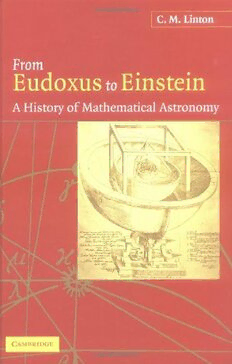
From Eudoxus to Einstein: a history of mathematical astronomy PDF
Preview From Eudoxus to Einstein: a history of mathematical astronomy
FromEudoxustoEinstein AHistoryofMathematicalAstronomy Sincemanfirstlookedtowardstheheavens,agreatdealofefforthasbeenputinto tryingtopredictandexplainthemotionsoftheSun,Moon,andplanets.Developments inman’sunderstandinghavebeencloselylinkedtoprogressinthemathematical sciences.Wholenewareasofmathematics,suchastrigonometry,weredevelopedto aidastronomicalcalculations,andonnumerousoccasionsthroughouthistory breakthroughsinastronomyhavebeenpossibleonlybecauseofprogressin mathematics.Thisbookdescribesthetheoriesofplanetarymotionthathavebeen developedthroughtheages,beginningwiththehomocentricspheresofEudoxusand endingwithEinstein’sgeneraltheoryofrelativity.Itemphasizestheinteraction betweenprogressinastronomyandinmathematics,showinghowthetwohavebeen linkedinextricablysinceBabyloniantimes.Thisvaluabletextisaccessibletoawide audience,fromamateurastronomerstoprofessionalhistoriansofastronomy. Christopher Linton isheadoftheMathematicalSciencesDepartmentand ReaderinAppliedMathematicsatLoughboroughUniversity.Heisamemberofthe LondonMathematicalSociety,theBritishSocietyfortheHistoryofMathematics,and theBritishSocietyfortheHistoryofScience. From Eudoxus to Einstein A History of Mathematical Astronomy C. M. LINTON DepartmentofMathematicalSciences,LoughboroughUniversity cambridge university press Cambridge, New York, Melbourne, Madrid, Cape Town, Singapore, São Paulo Cambridge University Press The Edinburgh Building, Cambridge cb2 2ru, UK Published in the United States of America by Cambridge University Press, New York www.cambridge.org Information on this title: www.cambridge.org/9780521827508 © C. M. Linton 2004 This publication is in copyright. Subject to statutory exception and to the provision of relevant collective licensing agreements, no reproduction of any part may take place without the written permission of Cambridge University Press. First published in print format 2004 isbn-13 978-0-511-21646-6 eBook (NetLibrary) isbn-10 0-511-21646-7 eBook (NetLibrary) isbn-13 978-0-521-82750-8 hardback isbn-10 0-521-82750-7 hardback Cambridge University Press has no responsibility for the persistence or accuracy of urls for external or third-party internet websites referred to in this publication, and does not guarantee that any content on such websites is, or will remain, accurate or appropriate. ToMatthewandHeleni Contents Preface pageix 1 Introduction 1 2 Spheresandcircles 25 3 ThePtolemaicuniverse 51 4 Developmentsingeocentricastronomy 85 5 Theheliocentricuniverse 119 6 TychoBrahe,Kepler,andtheellipse 153 7 Galileo,thetelescope,andKeplerianastronomy 201 8 Theuniversaltheoryofgravitation 239 9 Celestialmechanics 291 10 Theasteroidsandtheouterplanets 355 11 Newmethods 397 12 Mercuryandrelativity 437 References 475 Index 503 vii Preface ‘Itisextremelyhardthesedaystowritemathematicalbooks,especiallyastro- nomicalones.’ThusbeginsKepler’sNewAstronomy,publishedin1609.While I would not attempt to claim that the problems I have faced are comparable with those Kepler had to tackle, he was after all working at the cutting edge ofboththemathematicsandastronomyofhisday;thepeculiardifficultiesthat faceauthorsofbookscontainingmathematics,butthemajorthrustsofwhich lieelsewhere,donotappeartohavechangedmuchoverthepassageoftime. A balancing act is required: how does one include sufficient technical detail accuratelytodescribetheproceduresinvolvedandnotenduplosingsightof themainfocus?Inthecontextofahistoricalsurveythereisanotherquestion: how faithful should one be to the form in which the mathematics was origi- nallywritten?Here,historiansandmathematicianswritingabouthistorytend totakedifferentapproaches.AsamemberofthelattercategoryIhavetaken theviewinthisbookthatitismoreimportanttounderstandwhatitisthatwas accomplishedthanpreciselyhowitwasachieved. Themathematicaldetailsthataregivenhopefullyservetoprovideamore comprehensivedescriptionofthedevelopmentofastronomicaltheoriesthanis usually found in general histories of astronomy. Sometimes the mathematics is described using the methods available at the time, but on other occasions modern mathematical language has been used to make the discussion easier to follow for the modern reader. I have tried to ensure that anachronisms are labelled clearly as such and that the resulting mixture of old and new is both informativeandnotmisleading. Thereisanenormousnumberofbookswrittenaboutthehistoryofastron- omy,avastsubjectspanning4000yearsofhumanhistory.Thestoryofman’s gradualappreciationofthenatureoftheheavensandthedevelopmentoftech- niques for predicting the future positions of celestial bodies is fascinating. It canbeappreciatedonmanylevels,andhistoriesofastronomyaboundwhich ix
